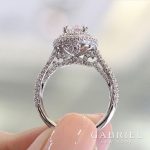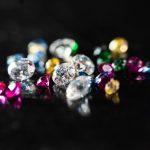Whether you are searching for a new diamond necklace, an engagement ring, or just a holiday present for a loved one you might notice that lab grown diamonds are now an option. If you have never looked into a diamond that was grown in a lab before, seeing the tag can toss you for a spin. You might be unsure of whether or not you want this type of diamond, and if it is worth the asking price. We are here to explain to you why lab grown diamonds in Littleton, CO are actually a suitable option for any jewelry option. In fact, for some people they are even a better option.
To start with, it is worth it to mention that some diamonds have a less than stellar history. At this point in time many people are aware of the unethical way that diamond miners can be treated and the damage that diamond mining can do to the environment. This is just the tip of the iceberg when it comes to the problems that surround the diamond trade, but lab grown diamonds don’t have any of these issues. In fact, since they are created in a lab and made by scientists, they are not linked to any of these issues.
Therefore, lab grown diamonds are a wonderful option for anyone who wants a diamond but doesn’t want any of the bad histories that are associated with them. When you purchase a diamond that is grown in a lab, you don’t have to feel any bit of regret about the process, which makes them a highly sought-after product for some in Littleton, CO. This alone is one reason you should talk to your jeweler to see where their diamonds are sourced from. Any professional jewelry shop with a licensed jeweler should be able to tell you the history of any diamond that you have in your mind.
What is the Difference Between Lab Diamonds and Traditional Diamonds?
At this point, you are probably wondering what the differences are between lab grown diamonds and the ones that are mined. After all, there must be some significant difference that separates them. The surprising fact is that there is actually not a difference at all. Most trained jewelers cannot tell the difference with the naked eye, and even at a molecular level, there are hardly any differences. This is because they are made under the same atmospheric conditions as a real diamond; the process is just expedited in a lab versus what happens in the natural world.
That’s right; they are exactly the same quality of gem, which means they are an excellent choice for any jewelry that you might be thinking about buying. The real bonus, in many cases lab grown diamonds are actually cheaper because they do not involve dining. While the process of making a diamond is still expensive, therefore demanding a high price tag, it is slightly cheaper than mining which means that you can sometimes get a deal on a diamond grown in a lab compared to the traditional diamond. When you consider the price of top-quality diamonds, most people will take advantage of the chance to save any tiny bit that they can.
How are Diamonds Made in a Lab?
Now that you know that lab grown diamonds and traditional diamonds are essentially the same, you might be curious about how they are actually made. It can be hard to wrap your brain around how this can possibly be true, but once you understand the process, it gets a bit easier to see why they would end up being the same quality. There are actually two ways to make a diamond in a lab, and while both processes are lengthy, they produce equally stunning results.
The first method of growing a diamond is called the High Pressure-High Temperature method, and involves the use of a small diamond seed that is then carefully placed into a carbon piece. The carbon is then pressurized to upwards of 1.5 million pounds per square inch which replicates the same amount of pressure that is in the lower cores of the earth. Then the carbon is exposed to excessively hot temperatures just like the core of the earth. The combination of heat and pressure slowly melts the carbon creating a diamond that encircles that original diamond seed. Then the diamond is slowly brought back down to a reasonable temperature and can be cut and used to make jewelry.
The second method of creating lab grown diamonds is called the chemical vapor deposition method and uses a small diamond that is placed inside of a chamber at hot temperatures. The difference is that this method uses carbon gasses such as hydrogen and methane to create the diamond growing environment. The gas is ionized which breaks down its molecular bond allowing pure carbon to stick to the diamond seed creating a much larger, new diamond. Sometimes heat and irradiation is used in conjunction with this method to alter the color of the diamond.
What is perhaps most interesting about growing lab grown diamonds is the time that it takes to create a finished diamond. While it can take millions of years for new diamonds to form in the crust of the earth, it usually takes less than a month to create a lab diamond. Colored diamonds can be created in just five to ten days while clear, white diamonds may take about three weeks. The process cannot be rushed due to the delicate nature of the crystal, but the results are still much faster than any other traditional diamond.
If you like the idea of a lab grown diamond, come down to Matheu’s Fine Watches & Jewelry where we are proud to stock lab diamonds for our Littleton, CO customers.





